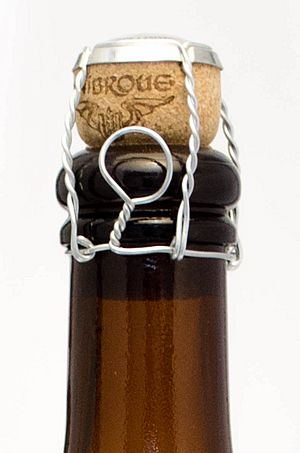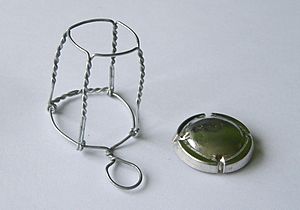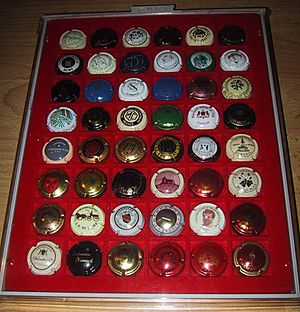Muselet facts for kids
A muselet is a special wire cage. It fits over the cork of bottles like champagne, sparkling wine, or beer. Its main job is to stop the cork from popping out. This happens because of the strong pressure from the fizzy drink inside. The word "muselet" comes from the French word museler, which means "to muzzle." This is like putting a muzzle on an animal to keep it from biting.
Muselets often have a small metal cap on top. This cap might show the drink maker's special design or logo. Usually, a metal foil wrapper covers the muselet and the top of the bottle. You might also hear muselets called wirehoods or Champagne wires.
The History of Muselets
When sparkling wines like champagne were first made, keeping the corks in was a big problem. Early bottles used wooden plugs sealed with oil-cloth and wax. But these plugs often leaked, or the pressure would make them pop out.
To solve this, people started using cords to hold the corks down. This was better, but still not perfect. Then, in 1844, a clever person named Adolphe Jacquesson came up with a new idea. He invented a more secure way using steel wire.
However, these first wire cages were hard to put on. They were also a bit tricky to open. Over time, the design got better. Today's muselets are made from strong steel wire. They have a small loop of wire at the bottom. You untwist this loop to release the muselet and get to the cork.
In Italy, a company called Cortellazzi started making muselets in 1952. The Cortellazzi brothers, Otello and Evangelista, had a metalworking shop. They invented the first machine that could make these wire cages from a single piece of wire. This invention finally solved the problem of losing the fizz from sparkling wines.
Modern Muselets and Their Use
Today, muselets are made by machines in huge numbers. They are designed to be easy to open. Usually, you need to turn the wire loop six half-turns to release the cork.
A cool new trend is personalized caps inside the muselet. These caps show the company's emblem or name. They can have different colors and designs each year. This has made collecting these tiny caps a popular hobby for some people!
See also
 In Spanish: Morrión (botella) para niños
In Spanish: Morrión (botella) para niños




